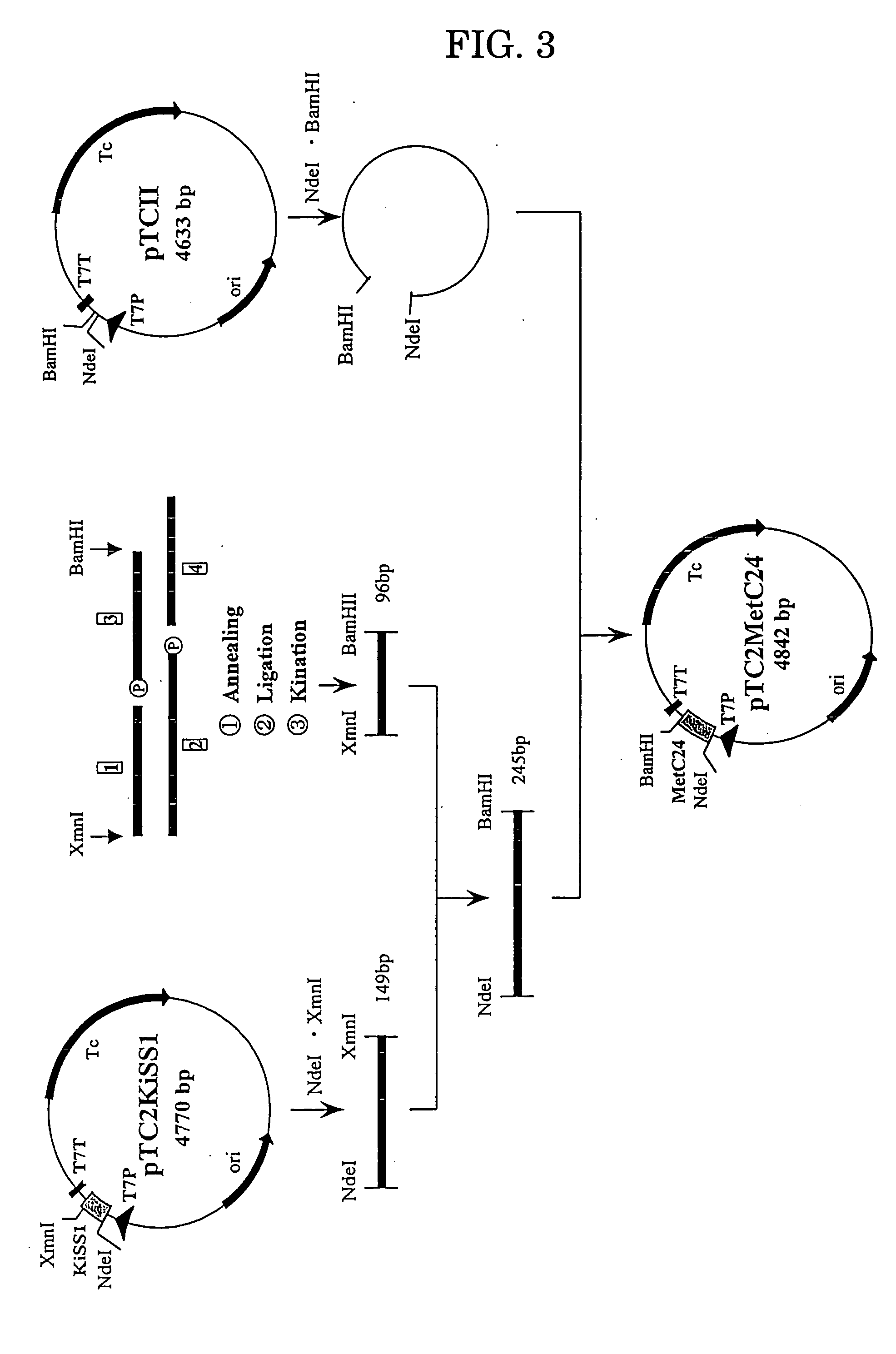Process for producing kiss-1 peptide
a kiss1 and peptide technology, applied in the direction of peptides, peptide sources, transferases, etc., can solve the problems of not being able to apply the prior art method which involves bromocyan to the production of methionine-containing peptides, and not being able to disclose the desired peptide from a protein, etc., to achieve efficient production
- Summary
- Abstract
- Description
- Claims
- Application Information
AI Technical Summary
Benefits of technology
Problems solved by technology
Method used
Image
Examples
example 1
[0202] (1) Production of DNA Encoding a KiSS-1 Peptide to Which 24 Amino Acids are Added at its C-Terminal
[0203] (a) Synthesis of DNA Fragments
[0204] The gene of the KiSS-1 peptide to which 24 amino acid residues are added to its C-terminal was prepared using four DNA fragments shown in FIG. 1 (#1, #2; 5′-terminal phosphorylated, #3; 5′-terminal phosphorylated, and #4: products of Kikotech).
[0205] (b) Ligation of the DNA Fragments for Adding at the C-Terminal
[0206] The DNA fragments #1 to #4 obtained in the above (a) were combined to a total volume of 40 μl. This mixture solution was maintained at 65° C. for 10 minutes and then gradually cooled to room temperature to effect annealing. The ligation reaction was conducted using T4 DNA Ligase (Takara Shuzo) to 10 μl of the annealing solution. Thus, 2 μl of 10× concentration of Ligation buffer and 1 μl of T4 DNA Ligase (350 units) were added to 10 μl of the annealing solution, and after thorough mixing, the ligation reaction was car...
example 2
[0214] To 70 g of the bacterial cells obtained in Example 1 was added 210 ml of a solution comprising 7 M guanidine hydrochloride, 100 mM Tris buffer and 1 mM EDTA (pH 8.0), and the mixture was dissolved under stirring and centrifuged (8,000 rpm, 60 minutes). The supernatant was diluted in a 4.2 L solution comprising 50 mM Tris buffer, 0.2 M arginine (pH 8.0), 1 mM reduced glutathione and 0.1 mM oxidized glutathione, and stood overnight in a low-temperature room. This solution was diluted 4 times with 1 M urea solution, adjusted to pH 6.0 with acetic acid, and applied to a SP-Toyopearl 550C column (5 cm ID×20 cm L, Tosoh) equilibrated with 50 mM MES-NaOH buffer (pH 6.0), at a flow rate of 750 mL / hour, for adsorption. The column was washed with 50 mM MES-NaOH buffer+0.2 M NaCl (pH 6.0) and then elution was carried out with 50 mM MES-NaOH buffer+0.5 M NaCl (pH 6.0). This eluate was diluted 3 times with distilled water, was applied to a SP-5PW column (21.5 mm ID×150 mm L, Tosoh) equili...
example 3
[0215] Determination of KiSS-1 Peptide Characteristics
[0216] a) Amino Acid Composition Analysis
[0217] The amino acid composition was determined using an amino acid analyzer (Hitachi model L-8500A amino acid analyzer). As a result, the amino acid composition was in agreement with that deduced from the base sequence of the DNA for KiSS-1 peptide (Table 1).
TABLE 1Value deduced fromNumber of residuesbase sequence ofAmino acidper moleKiSS-1 peptideAsx3.44Thr*)0.91Ser*)7.18Glx7.17Pro8.28Gly5.15Ala3.03Cys00Val1.92Met00Ile1.01Leu55Tyr1.01Phe1.92His1.01Lys1.01Arg3.94Trp0.41
Acid hydrolysis (mean value after acid hydrolysis in 6 N HCl-4% thioglycolic acid for 24-48 hrs)
*)Value obtained by extrapolation to 0 hr.
b) N-terminal Amino Acid Sequence Analysis
[0218] The N-terminal amino acid sequence was determined using a gaseous phase protein sequencer (PE Applied Biosystems model 492). As a result, the N-terminal amino acid sequence was in agreement with that deduced from the base sequence o...
PUM
| Property | Measurement | Unit |
|---|---|---|
| temperature | aaaaa | aaaaa |
| temperature | aaaaa | aaaaa |
| temperature | aaaaa | aaaaa |
Abstract
Description
Claims
Application Information
 Login to view more
Login to view more - R&D Engineer
- R&D Manager
- IP Professional
- Industry Leading Data Capabilities
- Powerful AI technology
- Patent DNA Extraction
Browse by: Latest US Patents, China's latest patents, Technical Efficacy Thesaurus, Application Domain, Technology Topic.
© 2024 PatSnap. All rights reserved.Legal|Privacy policy|Modern Slavery Act Transparency Statement|Sitemap



